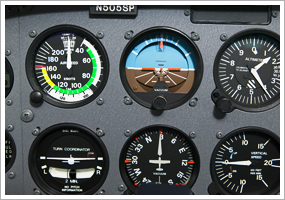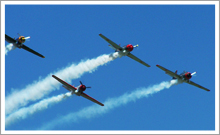| ||||
| | FT News | INSIDE AOPA | TRAINING PRODUCTS | FINAL EXAM | |||
TRAINING TIPsStall recognition What indications does your aircraft give that it is about to stall? It’s good and necessary for a pilot to be able to recover properly from an incipient or full stall. But there’s a higher level of skill and awareness in being able to recognize the developing deterioration of aerodynamic performance. That skill boosts safety—and satisfies the knowledge requirement for your practical test.
When you think about the indications your aircraft may provide that it is about to stall, don’t just content yourself with automated warnings such as a stall horn or visual display. Your ability to sense your aircraft’s aerodynamic condition could be your first alert—and after all, warning systems might fail. As described in the Private Pilot Practical Test Standards’ power-off stalls task, satisfactory performance is achieved when the applicant “recognizes and recovers promptly after the stall occurs by simultaneously reducing the angle of attack, increasing power to maximum allowable, and leveling the wings to return to a straight-and-level flight attitude with a minimum loss of altitude appropriate for the airplane.” How you recognize the stall does not depend on mechanical indications. Many stall warning systems are designed to activate a few knots before stall occurs.
If you had plenty of quality training maneuvering during slow flight, you’ll know how your trainer responds. Ralph Butcher took up this subject in his January 2003 Flight Training “Insights” column. See his list of aerodynamic demonstrations that sharpen stall-recognition skills.
Stall recognition is a natural extension of a pilot’s overall airspeed awareness. That’s the ability to “fly by feel.” If you have this knack, you can make fair estimates of airspeed based on control effectiveness, and how much adverse yaw (aileron drag) occurs during maneuvers. Airspeed awareness was reviewed in the Feb. 15, 2002, “Training Tip.” “Such skills enhance safety, providing sensory clues to aid in stall recognition and avoidance. They reduce pilot workload. They enhance passenger comfort, because the smoothness of the pilot becomes the smoothness of the ride,” it said.
That’s a lot of benefit for mastering one fundamental skill. More than just something to ace for a flight test, showing your stall recognition smarts guarantees that pilot and aircraft are truly functioning as one. YOUR PARTNER IN TRAININGAt one time or another, most pilots upgrade airplanes. In many cases these upgraded aircraft are significantly more powerful and faster than the trainer you may be flying now. How do they differ, and how can you prepare when the time comes? The differences are endless, but AOPA has resources to get you started. Visit the AOPA Pilot Information Center’s guide to stepping up. It has information on regulations, training tips, and more.
Did you know that student pilots who join AOPA are three times more likely to complete their flight training? Membership includes unlimited access to aviation information by phone (800/USA-AOPA, weekdays from 8:30 a.m. to 6 p.m. Eastern time) or from AOPA Flight Training Online or AOPA Online. If you're not already a member, join today and get the pilot's edge. Login information is available online. FLIGHT TRAINING NEWSNTSB report on glass cockpits leaves unanswered questionsAn NTSB study released March 9 that concluded glass cockpit aircraft were no safer than conventional instrument aircraft and recommended the FAA implement numerous training requirements falls short, according to AOPA. The recommendations call for the FAA to enhance pilot knowledge and training requirements, require training on PFDs, support equipment-specific training, require manufacturers to provide pilots with information to better manage system failures, and remind pilots to report equipment malfunctions through the service difficulty reporting system. Read more >> Upset training available onlineAviation Performance Solutions LLC, a company specializing in various forms of unusual attitude and upset training, is now offering pilots online training. The program consists of online video ground training that covers such topics as the steps needed to resolve any recoverable stall or unusual attitude, and why yaw and mishandling rudder can be deadly. The first 2.5 hours of video is $1, followed by $69 per module for the remainder of the course. Partnership offers helicopter degreeGreat Lakes Helicopter and Conestoga College in Kitchener, Ontario, will begin offering a new two-year helicopter degree program in September 2011. The partnership created Ontario’s first diploma program for aspiring helicopter pilots. The agreement expands Conestoga College’s diploma-level program in aviation by allowing students to achieve a commercial helicopter pilot certificate as well as an Ontario college diploma. Previously, students in this program were limited to fixed-wing training with Waterloo-Wellington Flight Centre. Read more >> School briefs:
inside aopaHotspots highlight risky intersectionsUnfamiliarity with an airport can be the first link in a chain that leads to a runway incursion. Reviewing taxi diagrams before you start can help you prepare for the twists and turns between taxi and take off or touchdown and the ramp, and now you may be able to see exactly where other pilots have gone wrong: AOPA Airports, the association’s new airport directory, features runway “hotspots,” depicting common runway-incursion-prone areas for certain airports. So far, 64 airports show high-alert areas; the AOPA Air Safety Foundation is adding hotspots as it gets the information from the FAA Office of Runway Safety. See an example of the new feature on the Palm Beach International page. Just click on the “Hotspots” tab above the Google map. Road and Runway Rally a successIt took a solid four days of adventure, but Team Orville and Team Wilbur from AOPA’s Road and Runway Rally made it to Sun ‘n Fun in Lakeland on April 13. Between Maryland and Florida the teams turned an average road trip into one of a lifetime with unique and interesting stops. The circus, a racetrack, and a monster truck dirt course were just a few of the fun stops. Team Wilbur even took the opportunity to do some flight training. Read more >> Renting an aircraft? Make sure you’re coveredNow that the spring flying season is in full swing, pilots are spending their free time getting caught up on their flying. If you are renting an aircraft, it’s crucial to understand that you must have renters insurance. Many pilots mistakenly believe that the FBO or other entity that rents the aircraft includes the renter under its insurance. But the FBO protects itself, not you, so before you head down the runway, make sure your insurance protection is in place. Read more >> TRAINING PRODUCTSSporty’s Flight DeskSporty’s Pilot Shop recently introduced a slim, convenient way to carry both a kneeboard and a flight bag. The Deluxe Flight Desk looks like a zippered binder, but it opens to reveal places for charts, notes, and approach plates. There are lots of pockets to store items you might need quickly as well. The Deluxe Flight Desk sells for $39.95. FINAL EXAMQuestion: How do I know when a crosswind is too strong for me to land my aircraft safely? Answer: You might want to begin by determining the crosswind component for the runway on which you intend to take off or land. The crosswind component is the wind component measured in knots at 90 degrees to the longitudinal axis of the runway. You can find both the headwind and crosswind component using a crosswind component chart. Next, you can determine whether or not this value exceeds the maximum demonstrated crosswind component of the aircraft you are flying. Most manufacturers will furnish that value in the pilot's operating handbook or flight manual. The maximum demonstrated crosswind component lets you know the airplane can handle at least the listed amount of crosswind. Finally, don't forget to figure in your own capabilities and experience as a pilot. The aircraft may be able to handle a stronger crosswind than you can. For more information on crosswinds and operations in windy weather, see AOPA’s subject report Windy Flight Operations, and read the AOPA Air Safety Foundation’s Safety Advisor, Mastering Takeoffs and Landings . Got a question for our technical services staff? E-mail [email protected] or call the Pilot Information Center, 800/872-2672. Don’t forget the online archive of “Final Exam” questions and answers, searchable by keyword or topic. Picture Perfect
AVIATION EVENTS & WEATHER To include an event or to search all events in the calendar, visit AOPA Online. For airport details, including FBO fuel prices, see AOPA’s Airport Directory Online. Flight Instructor Refresher ClinicsThe next AOPA Air Safety Foundation Flight Instructor Refresher Clinics are scheduled in Denver, Colo., Boston, Mass., and Salt Lake City, Utah, April 17 and 18; Tampa, Fla., Atlanta, Ga., and Indianapolis, Ind., April 24 and 25. For a complete schedule, see AOPA Online. Can’t make it in person? Sign up for the CFI Refresher Online. AOPA Air Safety Foundation Safety SeminarsAOPA Air Safety Foundation Safety Seminars are scheduled in Lakeland, Fla., April 16; West Lafayette, Ind., and Timonium, Md., April 21; Blacksburg, Va., April 26; Danville, Va., April 27; Morris Plains, N.J., and Richmond, Va., April 28; Hampton, Va., April 29; Morganton, N.C., May 1; Jamestown, N.C., and Poughkeepsie, N.Y., May 3; Smithfield, N.C., and Cohoes, N.Y., May 4; New Bern, N.C., and Rochester, N.Y., May 5; Newton, Mass., and Madison, Wis., May 10; Windsor Locks, Conn., and Milwaukee, Wis., May 11; Manitowoc, Wis., May 12. Topics vary—for details and a complete schedule, see AOPA Online. | Got news? Contact ePilot. Having difficulty using this service? Visit the ePilot Frequently Asked Questions now at AOPA Online or write to [email protected]. |
| Editorial Team: ePilot Flight Training Editor : Ian Twombly | ePilot Editor: Sarah Brown | Contributor: Alton Marsh |


 Pilots love to take photos, and they love to share them with other pilots. Now you can upload your flying photos to our
Pilots love to take photos, and they love to share them with other pilots. Now you can upload your flying photos to our 

